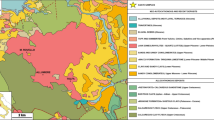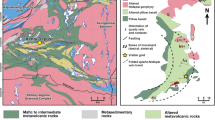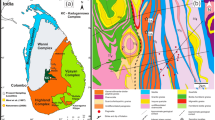Abstract
We studied both colloform-banded macro- and micro-textures as well as the composition of electrum from the epithermal Khan Krum (or Ada Tepe) gold deposit, Bulgaria (5 Mt at 5.1 g/t Au + 2.7 g/t Ag) using optical and electron scanning microscopy, vibration spectroscopy, electron micro-probe analysis, and LA-ICP-MS. The individual textural bands differ in grain size, porosity, quartz-to-adularia ratio, and abundance of electrum, pyrite, and scattered dusty opaque micro-inclusions. The individual macro-bands have formed successively via intermittent fault dilation from episodic hydrothermal pulses, as a result of regional extension and most likely originated from colloidal solutions formed by vigorous boiling during rapid pressure drop and supersaturation with respect to amorphous silica in a closed or quasi-closed hydrothermal system. Electrum is highly concentrated in the finest quartz–adularia colloform micro-bands, which fill joints with widths up to 1–2 mm. We presume that the joints have filled in with more concentrated colloidal solutions than those in the macro-bands, most likely due to extreme boiling of fluids in open or quasi-open hydrothermal system. Electrum in the micro-bands forms transverse dendrite- and chain-like aggregates as well as oval clots along the banding, all of globular morphology. We explain these locations of electrum with reorientation of aggregated electrum globules during plastic deformation of a mixed electrum–silicate gel and in result from the consequent crystallization of silicates. At the same time, electrum is not present in pores and cracks of syneresis, which indicates that it had not been a soluble phase at the time of syneresis, rather colloidal particles. Electrum also forms dense sprinkles of globular morphology deposited in open space on the surfaces of some quartz–adularia bands, due to a condensation of gaseous phase, separated during the boiling of fluids. We found that the electrum-rich quartz–adularia micro-banding is enriched (in descending order) in Bi, Te, Cu, Fe, Pb, Au, As, U, Ba, Zn, Mg, Cr, Al, Tl, Na, K, and Th, and is slightly depleted in Si, Ti, Se, Ag, and Sb in comparison with the electrum-poor macro-bands. Ca displayed equal abundances in both macro- and micro-bands. The highest grades of electrum correspond to the highest abundances of Fe, As, Cu, Pb, Zn, Bi, and Te, which have deposited as sulfides and tellurides, thus revealing the voluminous electrum deposition in response to a significant decrease of sulfur and tellurium activities, and transport of gold and silver in the paleofluids in the form of sulfuric and telluric complexes. The epithermal Khan Krum deposit is Au dominant, Bi and Te rich, thus indicating its relationship to an igneous source.











Similar content being viewed by others
References
Adams SF (1920) A microscopic study of vein quartz. Econ Geol 15:623–664
Bonev N (1996) Tokachka shear zone southwest of Krumovgrad in Eastern Rhodopes, Bulgaria: an extensional detachment. Ann Univ Sofia 1-Geol 89:97–106
Bonev N (2002) Structure and evolution of the Kessebir gneiss dome, Eastern Rhodope. Dissertaion, University of Sofia (in Bulgarian)
Bonev N, Marchev P, Singer B (2006) 40Ar/39Ar geochronology constraints on the Middle Tertiary basement extentional exhumation and its relation to ore-forming and magmatic processes in the Eastern Rhodope (Bulgaria). Geodin Acta 19:267–282
Bonev N, Moritz R, Marton I, Chiaradia M, Marchev P (2009) Geochemistry, tectonics, and crustal evolution of basement rocks in the Eastern Rhodope Massif, Bulgaria. Internat Geol Rev 52:269–297
Bonev N, Marchev P, Ovtcharova M, Moritz R, Ulianov A (2010) U–Pb LA-ICP/MS zircon geochronology of metamorphic basement and Oligogene volcanic rocks from the SE Rhodopes: inferences for the geological history of the Rhodope crystalline basement. In: Proceedings of Nat Confer of the Bulgarian Geol Soc. Sofia, pp. 115–116
Bonev N, Spikings R, Moritz R, Marchev P (2010) Timing of extensional exhumation of the Eastern Rhodope high-grade basement (Bulgaria): 40Ar/39Ar constraints. In: Proceedings of Nat Confer of the Bulgarian Geol Soc. Sofia, pp. 117–118
Browne PRL (1978) Hydrothermal alteration in active geothermal fields. Ann Rev Earth Planet Sci 6:229–250
Browne PRL, Lawless JV (2001) Characteristics of hydrothermal eruptions, with examples from New Zealand and elsewhere. Earth Sci Rev 52:299–331
Buchinan LJ (1981) Precious metal deposits associated with volcanic environments in the Southwest. Ariz Geol Soc Dig 14:237–262
Chuhrov FV (1955) Colloids in the Earth crust. Izd AN SSSR, Moscow (in Russian)
Dong G, Morrison G (1995) Adularia in epithermal veins, Queensland: morphology, structural state and origin. Miner Deposita 30:11–19
Dong G, Morrison G, Jaireth S (1995) Quartz textures in epithermal veins, Queensland—classification, origin, and implication. Econ Geol 90:1841–1856
Fournier RO (1985) Silica minerals as indicators of conditions during gold deposition. In: Tooker EW (ed) Geological characteristics of sediment- and volcanic-hosted disseminated gold deposits—search for an occurrence model; USGS Bulletin 1646, pp 15–26
Georgiev V (2007) Eastern Rhodopian ore region. In: Milev V (ed) Gold deposits in Bulgaria. Zemya’93, Sofia, pp 98–140, in Bulgarian
Gibert F, Pascal M, Pichavant M (1998) Gold solubility and speciation in hydrothermal solutions: experimental study of the stability of hydrosulphide complex of gold (AuHSο) at 350 to 450 °C and 500 bars. Geochem et Cosmochim Acta 62:2931–2947
Goranov A, Kozhoukharov D, Boyanov I, Kozhoukharova E (1995) Explanatory note to the geological map of Bulgaria at 1:100 000 scale, Krumovgrad and Sape map sheets. Avers, Sofia (in Bulgarian, abstract in English)
Grigor’ev DP (1953) On the genesis of flowstones or metacolloidal, colloform mineral aggregates. Zap vsesoyusn min obscht 1:7–21 (in Russian)
Grigor’ev DP (1965) Ontogeny of minerals. Israel Program for Scientific Translations Ltd, Jerusalem
Haranczyk C (1969) Noncolloidal origin of colloform textures. Econ Geol 64:466–468
Hayashi K-I, Maruyama T, Satoh H (2001) Precipitation of gold in a low-sulfidation epithermal gold deposit: insights from a sub-millimetre-scale oxygen isotope analysis of vein quartz. Econ Geol 96:211–216
Hedenquist J, Lowenstern J (1994) The role of magmas in the formation of hydrothermal ore deposits. Nature 370:519–527
Herdianita NR, Browne PRL, Rodgers KA, Campbell KA (2000) Mineralogical and textural changes accompanying ageing of silica sinter. Miner Deposita 35:48–62
Herrington RJ, Wilkinson JJ (1993) Colloidal gold and silica in mesothermal vein systems. Geology 21:539–542
Jelev D (2007) Khan Krum gold deposit, Ada Tepe prospect. In: Milev V (ed) Gold deposits in Bulgaria. Zemya’93, Sofia, pp 104–115, in Bulgarian
Jelev D, Hasson S (2002) Geology of Khan Krum gold deposit. In: Dabovski C, Ivanov M (eds) Modern problems of the bulgarian geology. Abstracts, Sofia, pp 58–59
Kamenov GD, Perfit MR, Jonasson IR, Mueller PA (2005) High precision Pb-isotope measurements reveal magma recharge as a mechanism for the ore deposit formation: examples from Lihir Island and Conical Seamont, Papua New Guinea. Chem Geol 219:131–148
Kibarov P, Marchev P, Ovtcharova M, Raycheva R, Moritz R (2007) Petrology and Geochronology of Iran Tepe volvano, Eastern Rhodopes, Bulgaria: age relationship with the Ada Tepe gold deposit (preliminary data). In: Advances in Regional Geological and Metallogenic Studies in the Carpathians, Balkans, Rhodope Massif and Caucasus (Romania, Serbia, Bulgaria and Georgia). Abstracts, Bor, 4–7 Sept
Kingma K, Hemley R (1994) Raman spectroscopic study of microcrystalline silica. Amer Min 79:269–273
Koneev RJ, Khomich VG, Fatyanov II, Boriskina NG (2006) Tellurium and Selenium in the classifications of gold-silver deposits of Central and North-easter Asia. In: Cook N, Ozgenc I, Oyman T (eds) Au–Ag–Te–Se deposits. Proceedings of the 2006 Field Workshop, Izmir-Turkey, 24–29 Sept 2006, pp 93–95
Kunov A, Stamatova V, Atanasova R, Petrova P (2001) The Ada Tepe Au–Ag–polymetalic occurrence of low-sulfidation (adularia–sericite type) in the Krumovgrad district. Minno delo i geologia 4:16–20 (in Bulgarian)
Lebedev LM (1967) Metacolloids in endogenic deposits. Plenum Press, New York
Lehmann B, Dietrich A, Willianos A (2000) From rocks to ore. Internat J Earth Sci 89:284–294
Levitski D (1953) To the question for the significance of colloidal solutions during ore formation. In: Betehtin AG (ed) Main problems of the doctrine for magmatogenic ore deposits. Izd AN SSSR, Moskow, pp 309–331 (in Russian)
Lindgren W (1900) The gold and silver veins of the Silver City, De Lamar, and other mining districts in Idaho. US Geol Surv 3:65–256, 20th Annual Report
Lindgren W (1933) Mineral deposits, 1st edn. McGraw-Hill, New York
Marchev P, Singer B, Jelev D, Hasson S, Moritz R, Bonev N (2004a) The Ada Tepe deposit: a sediment-hosted, detachment fault-controled, low-sulfidation gold deposit in the Eastern Rhodopes, SE Bulgaria. Schweiz Mineral und Petrogr Mitt 84:59–78
Marchev P, Raicheva R, Downes H, Vaselli O, Chiaradia M, Moritz R (2004b) Compositional diversity of Eocene-Oligocene basaltic magmatism in the Eastern Rhodopes, SE Bulgaria: implications for genesis and tectonic seting. Tectonophysics 393:301–328
Marchev P, Kaiser-Rohrmeier M, Heinrich C, Ovtcharova M, von Quadt A, Raicheva R (2005) Hydrothermal ore deposits related to post-orogenic extensional magmatism and core complex formation: the Rhodope massif of Bulgaria and Greece. Ore Geol Rev 27:53–89
Marchev P, Arai S, Vaselli O (2006) Cumulate xenoliths in Oligocene alkaline basaltic and lamprophyric dykes from the eastern Rhodopes, Bulgaria: evidence for the existence of layered plutons under the metamorphic core complexes. Geol Soc Am Spec Pap 409:237–258
Marinova I (2005) Hypogene and supergene minerals in „Khan Krum” gold deposit, “Stenata” site (Eastern Rhodopes), at Tokachka detachment fault contact. Proceedings of the 80 Ann of the Bulgarian Geol Soc. Sofia, pp 168–170
Marinova I (2007) Morphometry of electrum from layer-like pervasive silicification in Stenata outcrop, low-sulfidation Khan Krum gold deposit, SE Bulgaria. Compt Rend Acad Bulg Sci 60:983–990
Marinova I (2008) Morphology of electrum from Khan Krum gold deposit, Krumovgrad goldfield, Eastern Rhodope Mountain, SE Bulgaria. Geologica Macedonica 2:111–120
Marton I (2009) Formation, preservation and exhumation of sedimentary rock-hosted gold deposits in the Eastern Rhodopes, Bulgaria. Ph.D. thesis, Terre & Environment 84, 134 pp
Marton I, Moritz R, Marchev P, Vennemann T, Spangenberg J (2006) Fluid evolution within Eastern Rhodopian sedimentary rock-hosted low-sulfidation epithermal gold deposits, Bulgaria. In: Cook NJ, Ozgens I, Oyman T (eds) Au-Ag-telluride-selenide deposits, Proceedings of the IGCP 486 2006 field workshop. Izmir, pp 116–123
Marton I, Moritz R, Bonev N, Marchev P (2007) Regional to local ore controls on the formation of sedimentary rock-hosted gold deposits from the Eastern Rhodopes, Bulgaria. In: Proceedings of 9th biennial SGA Meeting, Dublin, pp 137–141
Marton I, Moritz R, Spikings R (2010) Application of low-temperature thermochronology to hydrothermal ore deposits: formation, preservation and exhumation of epithermal gold systems from the Eastern Rhodopes, Bulgaria. Tectonophysics 483:240–254
Moritz R, Marton I, Chambefort I, Noverraz C (2007) Diversity of epithermal gold ore formation in southeastern Europe: a record of a protracted 60 m.y.-long geodinamic and metallogenic evolution of the Tethyan arc. In: Moritz R, Quadt A (eds) Advances in regional geological and metallogenic studies in the Carpathians, Balkans, Rhodope Massif and Caucasus (Romania, Serbia, Bulgaria and Georgia), Abstracts. SE Europe Geoscience Foundation, Bor
Moritz R, Marton I, Ortelli M, Marchev P, Voudouris P, Bonev Nm Spikings R, Cosca M (2010) A review of age constraints of epithermal precious and base metal deposits of the Tertiary Eastern Rhodopes: coincidence with late Eocene–Early Oligocene tectonic plate reorganization along the Tethys. Proc XIX CBGA Congr Tessaloniki 100:351–358
Nelson CE, Giles DL (1985) Hydrothermal eruption mechanisms and hot spring gold deposits. Econ Geol 80:1633–1639
Oen IS, Kieft C (1993) A metacolloidal dendrite-rich Bi–Ni–Co quartz vein, Pozoblanco, Spain. Min Mag 57:241–247
Paton C, Hellstrome J, Paul B, Woodhead J, Hergt J (2011) Iolite: freeware for the visualization and processing of mass spectrometer data. J Anal At Spectrom 26:2508–2518
Peycheva I, Ovtcharova M, Sarov S, Kostitsin Y (1998) Age and metamorphic evolution of metagranites from Kessebir reka region, Eastern Rhodopes—Rb–Sr isotope data. XVI Congress CBGA, Abstracts. Vienna, p. 471
Phillips WJ (1972) Hydraulic fracturing and mineralization. J Geol Soc London 128:337–359
Popov H, Jockenhövel A, Tsintsov Z, Iliev S (2011) Montanarhcäologische Forschungen in den Ostrhodopen, Südostbulgarien. In: Nikolov V, Bacvarov K, Popov H (eds) Interdisziplinäre Forschungen zum Kulturerbe auf der Balkanhalbinsel. Humboldt-Union in Bulgaria, Sofia, pp 253–290
Quincke G (1902) Die Oberflächenspannung an der Grenze wässeriger Colloidlösungen von verschiedener Conzentration. Ann Phys 314:969–1045
Rintoul L, Panayiotou H, Kokot S, George G, Cash G, Frost R, Bui T, Fredericks P (1998) Fourier transform infrared spectrometry: a versatile technique for real world samples. Analyst 123:571–577
Roedder E (1968) The noncolloidal origin of “colloform” textures in sphalerite ores. Econ Geol 63:451–471
Rogers AF (1917) A review of the amorphous minerals. J Geol 15:515–541
Sander MV, Black JE (1988) Crystallization and re-crystallization of growth-zoned vein quartz crystals from epithermal systems—implications for fluid inclusion studies. Econ Geol 83:1052–1060
Sanematsu K, Watanabe K, Duncan RA, Izawa E (2006) The history of vein formation determined by 40Ar/39Ar dating of adularia in the Hosen-1 vein. Econ Geol 101:685–698
Saunders JA (1990) Colloidal transport of gold and silica in epithermal precious-metal systems: evidence from the Sleeper deposit, Nevada. Geology 18:757–760
Saunders JA (1994) Silica and gold textures in bonanza ores of the Sleeper deposit, Humboldt County, Nevada: evidence for colloids and implications for epithermal ore-forming process. Econ Geol 89:628–638
Saunders JA (2012) Textural evidence of episodic introduction of metallic nanoparticles into bonanza epithermal ores. Minerals 2:228–243
Saunders JA, Brueseke M (2012) Volatility of Se and Te during subduction-related distillation and the geochemistry of epithermal ores of the western United States. Econ Geol 107:165–172
Saunders JA, Schoenly PA (1995) Boiling, colloid nucleation and aggregation, and the genesis of bonanza Au–Ag ores of the Sleeper deposit, Nevada. Miner Deposita 30:199–210
Saunders JA, Unger DL, Kamenov GD, Fayek M, Hames WE, Utterback WC (2008) Genesis of Middle Miocene hotspot-related bonanza epithermal Au–Ag deposits, Northern Great Basin, USA. Miner Deposita 43:715–734
Saunders JA, Virke P, Under DL, Beasley L (2011) Colloidal and physical transport textures exhibited by electrum and naumannite in bonanza epithermal veins from western USA, and their significance. In: Steininger R, Pennell W (eds) Great basin evolution and metallogeny, Geol Soc of Nevada 2010 Symposium, 14–22 May 2010, pp 825–832
Scott AM, Watanabe Y (1998) "Extreme boiling" model for variable salinity of the Hokko low-sulfidation epithermal Au prospect, southwestern Hokkaido, Japan. Miner Deposita 33:568–578
Seward TM (1973) Thio complexes of gold and the transport of gold in hydrothermal ore solutions. Geochim Cosmochim Acta 37:379–399
Shenberger DM, Barnes HL (1989) Solubility of gold in aqueous sulfide solutions from 150 to 350 °C. Geochim Cosmochim Acta 53:269–278
Sherlock RL, Lehrman NJ (1995) Occurrence of dendritic gold at the McLaughlin Mine hot-spring gold deposit. Miner Deposita 30:323–327
Shikazono N, Masataka N, Shimizu M (1990) Geochemical, mineralogic and geologic characteristics of Se- and Te-bearing epithermal gold deposits in Japan. Min Geol 40:337–352
Shimizu T, Matsueda H, Ishiyama D, Matsubaya O (1998) Genesis of epithermal Au–Ag mineralization of the Koryu Mine, Hokkaido, Japan. Econ Geol 93:303–325
Simmons SF, Browne PRL (1997) Saline fluid inclusions in sphalerite from the Broadlands-Ohaaki geothermal system: a coincidental trapping of fluids being boiled toward dryness. Econ Geol 92:485–489
Simmons SF, Christenson BW (1994) Origins of calcite in a boiling geothermal system. Amer J Sci 294:361–400
Simmons SF, Mauk JL, Simpson MP (2000) The mineral products of boiling in the Golden Cross epithermal deposit. In: Proceedings of the New Zealand Minerals & Mining Conference
Simpson CRJ, Mauk JL, Arehart GB, Mathews SJ (1995) The formation of banded epithermal quartz veins at the Golden Cross Mine, Waihi, New Zeland. In: Proceedings of the 1995 PACRIM Congress, pp 545–550
Thomas R, Davidson P (2012) Evidence of a water-rich silica gel state during the formation of a simple pegmatite. Min Mag 76:2785–2801
Wherry ET (1914) Variations in the compositions of minerals. J Wash Acad Sci 4:111–114
Williams-Jones AE, Heinrich CA (2005) Vapor transport of metals and the formation of magmatic-hydrothermal ore deposits. Econ Geol 100:1287–1312
Acknowledgments
The National Science Fund of Bulgaria (project DO-02-82/2008) is acknowledged for funding a part of this study. The Bulgarian Ministry of Education, Youth, and Science is acknowledged for the English translation and editing of this article financed by the “Science and Business” scheme of the project BG051PO001-3.3-05/0001 through the “Human Resources Development” Operative Program. The authors thank their colleagues from “Balkan Mineral and Mining” Co, especially Sean Hasson, Danko Jelev, and Tanya Kazulova for technical assistance. Thanks are due to Luchezar Petrov (Institute of Mineralogy and Crystallography at Bulgarian Academy of Sciences) for the SEM study and EMPA, and to Lyubomir Dimitrov and Lyudmil Konstantinov (same Institute) for fruitful discussions. Thanks are due to James Saunders for providing the authors with new papers on bonanza epithermal ores and for useful recommendations. The authors thank Robert Moritz for the review and Bernd Lehmann and Robert Moritz for efforts to improve the manuscript.
Author information
Authors and Affiliations
Corresponding author
Additional information
Editorial handling: R. Moritz
Rights and permissions
About this article
Cite this article
Marinova, I., Ganev, V. & Titorenkova, R. Colloidal origin of colloform-banded textures in the Paleogene low-sulfidation Khan Krum gold deposit, SE Bulgaria. Miner Deposita 49, 49–74 (2014). https://doi.org/10.1007/s00126-013-0473-4
Received:
Accepted:
Published:
Issue Date:
DOI: https://doi.org/10.1007/s00126-013-0473-4




